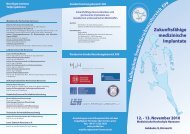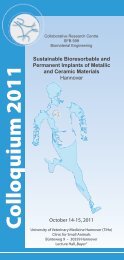Zukunftsfähige medizinische Implantate
Zukunftsfähige medizinische Implantate
Zukunftsfähige medizinische Implantate
Sie wollen auch ein ePaper? Erhöhen Sie die Reichweite Ihrer Titel.
YUMPU macht aus Druck-PDFs automatisch weboptimierte ePaper, die Google liebt.
Functionalized Middle Ear Prostheses<br />
Funktionalisierte Mittelohrprothesen<br />
Dr. Nina Ehlert, Tammo Lüßenhop, Olga Kufelt, Rebecca Lensing, Daniela Hesse, Nils<br />
Prenzler, Dr. Martin Stieve, Prof. Thomas Lenarz, Muhammad Badar, Prof. Peter P. Müller,<br />
Laura Doniga-Crivat, Dr. Silke Besdo, Prof. Peter Wriggers, Prof. Peter Behrens<br />
The aim of this project is the development of optimized middle ear implants, on the one hand<br />
by employing novel biomaterials to support the healing process after replacement of the<br />
ossicular chain and on the other hand by simulation techniques to achieve optimal<br />
functionality.<br />
As base for the functionalization of middle ear implants we chose prostheses made of<br />
Bioverit® II, a glass mica ceramic, and coated them with a nanoporous silica layer.<br />
Nanoporous materials are currently being investigated for possible applications as<br />
biomaterials. In several investigations we were able to show that nanoporous silica is<br />
basically biocompatible and has even a positive effect in the middle ear. [1-3]. Nevertheless<br />
modern biomaterials need to exhibit more specific biological functions. Therefore, we<br />
modified nanoporous silica and, for comparison, amorphous silica coatings with BMP2 (bone<br />
morphogenetic protein 2), a signalling protein which induces differentiation of bone-forming<br />
cells. The aim of this strategy was a stronger fixation of the prosthesis by establishing a<br />
connection between the prosthesis and the residual stapes bone. We have tested the<br />
biochemical and biological activity of BMP2 attached to the surface of nanoporous and plain<br />
amorphous silica. Additionally we made first in vivo experiments in a rabbit model.<br />
Furthermore the nanoporous silica layer can be employed as a drug delivery system. We<br />
made investigations with the antibiotic ciprofloxacin which is known to be effective against<br />
bacteria like Pseudomonas, which cause typical infections in the middle ear. Further<br />
functionalizations were developed to achieve a controlled release rate and to reduce the<br />
initial burst effect often observed [4]. The materials exhibit a good antibacterial efficacy<br />
against luminescent bacteria in vitro and in a rabbit and in a mouse model in vivo. Another<br />
approach to fight against chronic inflammations in the middle ear is the development of an<br />
antibacterial coating based on polymers.<br />
During the next period the main focus will be on the implant-tissue interactions and the<br />
healing process in the region of the ear drum as well as the addition of a cushioning element.<br />
The aim is the development of a collagen-composite scaffold which is supposed to act as a<br />
cushioning element between the ear drum and the prosthesis. Furthermore a combination<br />
with nanoporous silca nanoparticles in order to realize a drug delivery of antiproliferativa is<br />
possible. Simulation techniques support the development of the composite scaffold in order<br />
to optimize its shape and sound transmission behaviour.<br />
[1] C. Turck, G. Brandes, I. Krueger, P. Behrens, T. Lenarz, M. Stieve, Acta Oto-Laryngology 127, 8<br />
(2007) 801-808.<br />
[2] J.C. Vogt, G. Brandes, I. Krueger, P. Behrens, I. Nolte, T. Lenarz, M. Stieve, J. Mater. Sc.: Mater.<br />
Med. 19, 7 (2008) 2629-2636.<br />
[3] J.C. Vogt, G. Brandes, N. Ehlert, P. Behrens, I. Nolte, P.P. Mueller, T. Lenarz, M. Stieve, J.<br />
Biomater. Appl. 24, 2 (2009) 175-191.<br />
[4] N. Ehlert, M. Badar, A. Christel, S.J. Lohmeier, T. Luessenhop, M. Stieve, T. Lenarz, P.P. Mueller,<br />
P. Behrens, J. Mater. Chem., 2011, DOI: 10.1039/C0JM01487G.<br />
TP D1 Dr. rer. nat. Nina Ehlert





